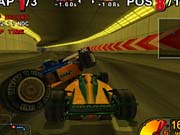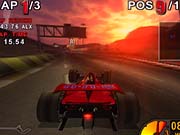Downforce is a very good example of why you shouldn't judge a book by its cover. Just because you've probably never heard of it, or aren't impressed by its unassuming box art, that doesn't mean Downforce isn't an enjoyable game. In fact, that's precisely what Downforce is--enjoyable. Though not for very long. It's a very accessible racing game, reminiscent of more serious F1- or Indy-style simulations, but it's infused with a healthy dose of gameplay from the likes of Wipeout and San Francisco Rush.

It's clear that this game was inspired by some kind of open-wheel racing league, as the racecars in Downforce all look like they're F1 cars from the not-so-distant future. They all boast aggressive, muscular designs, yet retain the same basic shape of modern-day racecars, with their prominent front and rear wings, pointy nose, massive air scoops, and open-air cockpit. Likewise, the tracks themselves are supposedly situated in recognizable cities like Las Vegas, Sydney, and Toronto, most of which play host to some form of racing venue in real life. And yet, the game certainly doesn't depict any kind of existing motorsport. Each car description is more outrageous than the next, as hyper-drive engines and turbo-fan reverse thrusters for brakes are the norm here.
Downforce is very simple to play, but it's not as forgiving as you'd imagine a game like this would be. As in any racing event, your goal is to cross the finish line first, but you'll need to employ generous use of your brakes while navigating the tracks' many tights corners and sweeping turns. The game delivers a great sense of speed, so it's never difficult to judge when you're going too fast into a turn, and unlike in hard-core driving simulators, braking late won't send you careening into a concrete wall. Still, if you're too aggressive, sooner or later you'll crash, and crash hard. The cars in Downforce can take quite a beating--you'll often see smoking engines or loose wings on your chassis--but if you slam into a barrier too fast, you'll bear witness to a spectacular crash that'll leave your car useless until it gets reset on the track after a few seconds.
But aside from these basic tenets of racing, Downforce has no additional gameplay mechanics, control schemes, or anything of the like. It's a simple game with a simple set of features. None of the cars, for example, has any kind of weapons, turbo boosts, or other powers-ups. Likewise, the game has no upgrades or aftermarket parts that you can use to modify your car after every race. What's more, even though the game has 10 playable cars and another four that can be unlocked in the career mode, it's not immediately obvious that their differences go beyond the shape and color of their chassis, despite their wild descriptions in the menu interface. Additionally, each car is supposedly piloted by a unique driver, but again, they never come into play beyond their physical depiction in the car selection menu.
Likewise, the game doesn't attempt to introduce any compelling gameplay modes beyond the genre's traditional quick race, time trial, free race, and career/championship modes. Like in most racing games, the championship mode in Downforce makes you race through the game's different racetracks (there are seven of them) in a specific order, and it awards points for finishing in the top three. The driver with the most points at the end of the championship is crowned the winner, and if you're that driver, then you'll unlock a new car and a new difficulty setting. There are 14 additional racetracks--seven for each of the two unlockable difficulty settings--but they're basically slight variations on the original seven. The game has a "trophy" gameplay mode, but that too is just a variation of its championship mode.
None of that is to say that Downforce isn't fun, because it is. Your opponents never relent, and they'll often try to bump you into a wall, but you'll never feel that the AI is cheating. There seems to be a hint of rubber-band AI, but it only serves to keep each race competitive, and if you build a sizeable lead, you'll never really have to worry about losing it if you can keep from slipping up too badly. Also, the damage that your car absorbs affects its performance noticeably. Lose a wing, for instance, and you'll lose traction, which makes your car skittish at high speeds and loose around the corners. Downforce even has a subtle drafting system that'll give you a slight speed advantage over any car that you trail closely behind.

Downforce's graphics and sound mimic the simple values exhibited by the rest of the game. While none of the cars or racetracks boasts a high number of polygons, the game does use a bright and colorful palette that's very easy on the eyes. And even though you won't be wowed by fancy special effects beyond the occasional lens flare, Downforce does run at a smooth and steady 60fps, and that's very important for a racing game. The game's soundtrack is composed of some fairly catchy and varied techno beats, and the sound effects aren't half bad either. The engine noises of the cars might all sound the same, but they're very loud and convincing--more so than in some pure driving simulations, in fact.
It's too bad that Downforce is as simple as it is. It's a very fun game to play, but there really isn't much to it. You'll likely finish the game in a few hours, and its multiplayer component is limited to a couple of split-screen modes that will grow old after a while. If you're put off by somewhat intimidating racing simulators like F1 2002 and are looking for an easy-to-get-into driving game, then Downforce is worth a look. Otherwise, it's best recommended as a rental--it'll make a thoroughly enjoyable one.